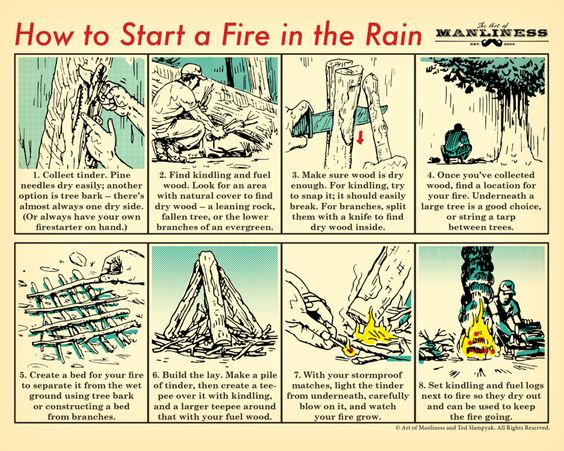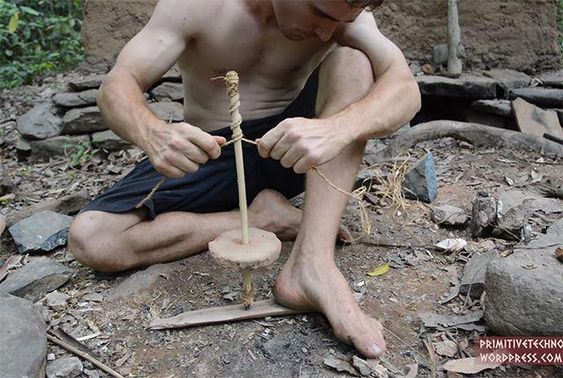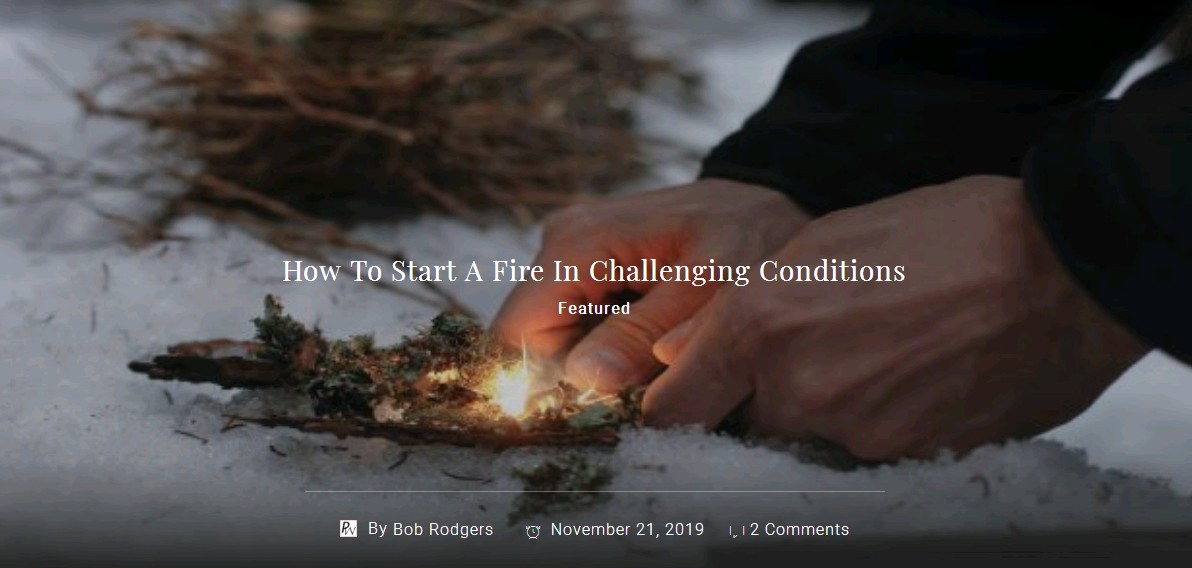🔥 Wilderness Preparation from the Field of Master Mind Survival (MMSUR) 🌲
Shared from the nature of: Joseph Mercado 👨
Article Author: Bob Rodgers 👴
To: Survivalist 🏃
Blog Post #842 📌
Re: How To Start a Fire In Challenging Conditions 📝
Date and Time: Friday, November 22, 2019 at 7:07 p.m. ⏰
Dear Survivalist,
Starting a fire should be a primary skill for every survivalist or outdoors enthusiast.
After all, the ability to make a fire in the wild provides great emotional comfort. Besides keeping you warm and allowing you to cook food or boil water, a campfire provides a state of tranquility that is much needed when things seem desperate.
3 Second SEAL Test Will Tell You If You’ll Survive A SHTF Situation
While starting a fire in the wilderness might not seem such a big deal, we must acknowledge that things will not always go as planned. In fact, there’s little to no information about what survivors should do to start a fire in challenging situations.
You need to test your ability to make and maintain a fire under various weather conditions and challenging situations. Below are a few scenarios that will put your skills to the test. These are not scenarios that I’ve made up, and in fact, I’ve learned how to test my fire making skills a few years ago when attending a survival course in the Rocky Mountains.
What I also learned was that some people might react to similar challenges with an emotional response rather than a pragmatic and logical solution. I recommend you do these tests without cheating and in a proper environment since real-world scenarios create high stress and you will be put to the test.
Even experienced survivalists or prepper’s can be challenged by these methods, and it will help them develop their fire starting skills even more.
Situations challenging your fire-starting skills…
Start a fire with cold and wet hands:

In the wilderness, slipping through the ice in the spring or capsizing in a canoe are common accidents. Cold water immersion will remove heat from your body in a matter of minutes. To not freeze to death or catch hypothermia, you will need to start a fire as quickly as possible.
In such scenarios, you will have to start a fire when you are cold, and your hands are borderline numb. I advise you not to try this method in the wild unless you have a heat source ready and waiting for you.
To be on the safe side, I recommend doing this challenge in the safety of your own backyard. You can submerge your hands in an ice bucket. Also, if you want to increase the difficulty, you can take your fire starter and hold it in the icy water with your hands.
You will notice that when your hands are shaking, it is rather difficult to start a fire. To succeed, keep in mind the following:
- Remove excess moisture from the hands.
- Remove moisture from the fire starting tools.
- Warm your hands a little bit. The fastest way to do so is by placing them under your armpits.
Starting a fire with just one match:
This is a challenge I do with the various people I go camping with, and it’s both a fun and learning experience for them. The idea is to start a fire with a single match, a round of wood and a knife.
Many people will fail to succeed because the match will burn out too quickly and their wood splits won’t ignite.
To be able to ignite the fuel you have, you can approach the situation from various angles. Some will decide to split the match, while others will create fast-burning fuzz sticks using the knife.
The best way to do it is to know a thing or two about wood batoning or how to split larger pieces of wood using your knife and a piece of wood.
Once you manage to split the wood into smaller quarters, you will need to shave the smaller parts into fast catching fuzz sticks. You will need to pay attention since this will test your blade handling skills, and some people may injure themselves.
Also, to make sure the fire lasts for as long as needed, make sure you don’t use all your fuel logs at once, and establish prior to starting the fire, what campfire you need to build.
Starting a fire at night, in complete darkness
This may seem like a joke to some, but it’s actually a challenging situation, and I encourage you to try it. To make things as real as possible, I recommend going into the woods, at a considerable distance from your camp and try this.
You will need a dark night with little moonlight or light pollution since the challenge here is to build a fire without using a flashlight.
You will soon understand that making a fire based on feel alone rather than sight is very difficult. Not to mention that using your Ferro rod will disrupt your natural night vision. You will be blinded by the sparks, and your sight and aiming capacities will be impaired.
To succeed in starting the fire, the trick is not to look directly at your hands and tools, and use mainly your peripheral vision. Squinting your eyes will also help, and scrapping with the Ferro rod, rather than down into it will prevent you from disrupting the fire setup.
Starting a fire when injured:

If you have experience exploring the great outdoors, you probably know by now that accidents happen in the wilderness. Most people will simply fall and hurt themselves since they are not using all their senses or watching their step. For the average humans, the typical reaction to failing is bracing the fall with their hand(s). In the majority of cases, this will result in a broken arm or injured wrist.
If you happen to find yourself in such a scenario, you will need to use a single hand (the healthy one) to start a fire. The challenge here would be to use only one hand and various fire starters.
Of course, that using a lighter should be no problem, but the situation changes drastically when you need to operate other fire-starting tools that would, in normal conditions, require the use of both hands.
Since there are many ways to start a fire, I recommend you try this for yourself and use your imagination. For example, if you have a metal match, you can use your feet to hold the scraper and use your good hand to handle the rod. Another example would be to use your Ferro rod by holding it down near the tinder with your boot and use the striker with the functioning hand.
You will notice that both scenarios require patience and attention to avoid knocking over the tinder or injuring yourself.
Using the two is one, one is none rule:
During the winter season, making a fire is even more challenging. Snow falling from above evergreen and damp ground can ruin your fire setup and make way for frustration to settle in. This scenario may seem easy for experienced campers or survivalist, but for some, it can be quite a challenge. The idea here is to throw water or snow over a fire that is lit but hasn’t settled yet.
Depending on the construction, some fire setups will shed water and shield the flame while others will be exhausted. You will have to re-light the fire as quickly as possible without wasting precious time.
The solution here is a simple one, but many fail to see it because they only focus on the end result rather than on the ongoing process. The two is one, and one is none rule is simple, and it means that one should never use all the fire-starting material in a single effort and leave some aside in case they need to re-light the fire.
A final challenge – Fire signaling:
This is more like a team activity, and it’s one of the survival training exercises I’ve learned that involves more than one person. Divide your camping group into teams of two or three people and ask them to build a fire that needs to reach a certain height in an established time frame.
The idea behind this training is to learn to start a noticeable signal fire in a short amount of time to have better chances of being rescued.
Attach a paracord or rope between two trees or posts, and the fire that is hot and high enough to burn through the paracord wins. To make this even more challenging and difficult, when a team is making the fire, a neutral party or the other teams should add pressure on them to increase their stress level.
Mistakes will be made, and it’s the perfect occasion to have a good after-action discussion to expose those errors and learn from each other. This is more like a bonding exercise and will teach you how to collaborate and communicate with your survival group. To succeed you need to know how to make the right fire time as this is the most decisive factor.
I will let you figure out this one for yourself and don’t cheat by building your fire on a platform.
Concluding:
Learning to start and maintain a fire under stressful conditions should be your next step in developing your fire-making skills. As prepper’s and survivalists, we should never become too comfortable with our training and believe we know it all.
Scenarios like the ones listed in this article may one day become real for you and yours, and it’s better to know how to handle them. Always keep in mind the basics of starting a fire since they will influence your success and help you deal better with frustration and impatience.
About the Author:
Bob Rodgers is an experienced prepper and he strives to teach people about emergency preparedness. He quit the corporate world and the rat race 6 years ago and now he dedicates all his time and effort to provide a self-sufficient life for his family. He loves the great outdoors and never misses a chance to go camping. For more preparedness related articles, you can visit him at Prepper’s Will.
Content Source: Survivopedia.com 🌎

Email Us a Message
➡ Have a question about this blog post❓
Please send us an email message below and we will serve you with an answer momentarily. 📩


